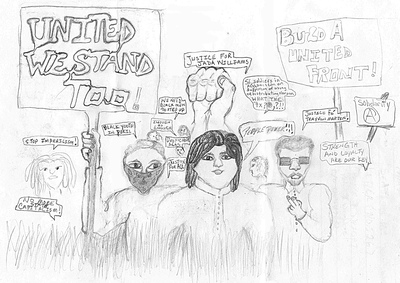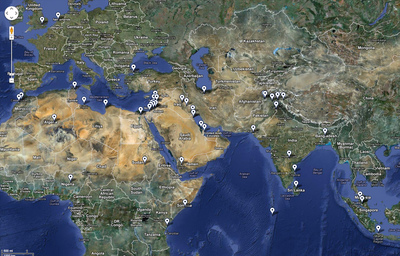Nos aproximamos al quinto aniversario como organización al reunir
nuestro Tercer Congreso. Aunque miembros de MIM(Prisiones) - y por
supuesto aquellos de USW - han estado en el movimiento de prisiones por
mucho mas tiempo, encontramos que esta es una oportunidad apropiada para
reflexionar acerca de donde se encuentra el movimiento de prisiones y
como se ha desarrollado.
Una serie de huelgas de hambre en California, durante el año 2011, tuvo
un gran impacto a lo largo de la nación. Muchos activistas, desde
aquellos encubiertos, hasta anarquistas y reformistas, se unieron
alrededor de este movimiento y como resultado continuaron enfocándose en
el trabajo de prisiones. Mientras nuestros predecesores en MIM habían
visto la importancia del movimiento de prisiones desde décadas atrás, su
visión ha sido afirmada mucho mas el día de hoy cuando comenzamos a
alcanzar una masa crítica de actividad. Es ahora un tópico caliente en
el nacionalismo blanco de izquierda, lo cual es significativo puesto que
los blancos no son afectados por el sistema de prisiones de una manera
tan extensa como para considerarlo un interés legítimo y prioritario.
Este desarrollo gradual ha sido el resultado de dos factores: Una
conmoción por fuera de las prisiones debido a los hechos alrededor del
sistema de injusticia de los Estados Unidos, y a prisioneros
organizándose en el interior de las cárceles; factores en los cuales MIM
y USW han estado trabajando diligentemente por décadas. En el año y
medio que ha pasado, la organización de los prisioneros alcanzó un
momento importante con la huelga de Georgia y las huelgas de hambre de
California, las cuales fueron coordinadas a un nivel estatal. Estos
eventos fueron particularmente significativos entre los prisioneros,
pero al mismo tiempo capturaron la atención de los medios y de la
comunidad internacional. Más aun, porque hay una serie de acciones
similares que continúan desarrollándose a lo largo del país.
(Recientemente en Virginia, Ohio, Texas, Illinois, la prisión federal
súper máxima ADX, Limon en Colorado y una huelga de hambre adicional en
Georgia.)
Entre tanto, el aspecto de conmoción llego a un punto importante con la
publicación del libro “The New Jim Crow” (El nuevo Jim Crow), el año
pasado. Este libro ha logrado conseguir bastante atención en sectores
diferentes del espectro político. Aunque mucha de la promoción le presta
atención indebida a las conclusiones tibias del libro, el hecho de que
los datos se hayan organizado en un libro hablan por si mismos. Se
requiere unas nociones preconcebidas muy arraigadas para leer este libro
y atreverse a negar la opresión del sistema de injusticia americano
contra las seudo colonias internas. Por lo tanto, pensamos que el efecto
general del libro será progresivo y significativo a pesar de sus
limitaciones.
Es por estas razones que vemos la necesidad de apoderarnos del momento.
Cuando comenzamos hace cinco años tuvimos la gran fortuna de construir
sobre el legado de los programas de soporte a los prisioneros,
establecidos por MIM. La fundación ideológica de MIM nos permitió
enfocar nuestras energías en asuntos mas prácticos, tal como el lanzar
una publicación nueva para las prisiones, construir programas de ayuda a
camaradas que son liberados, desarrollar cursos por correspondencia de
estudios políticos, y lanzar un nuevo sitio de Internet que exhiba
información amplia sobre censura, reglas de correo y abusos en las
prisiones del país.
Con nuestra infraestructura ya terminada y trabajando correctamente,
necesitamos ahora buscar maneras de tomar ventaja inmediata de la
conciencia relativamente positiva de los prisioneros y de la atención
relativa que la población americana le ha dado al sistema de prisiones.
Siempre hemos mantenido que sin prisioneros organizados no hay
movimiento de prisiones, es así que tenemos ese objetivo como nuestra
prioridad inicial. Estamos tomando pasos para mejorar la estructura de
United Struggle from Within (USW), la organización de masas de
prisioneros que fue fundada por MIM ye es ahora liderada por
MIM(Prisiones). Construyendo sobre las sugerencias de algunos líderes en
USW, hemos habilitado un plan para formar asambleas en estados donde hay
múltiples células activas de USW. Más adelante explicarémos una
organización estructural para nuestro movimiento de manera que los
camaradas puedan saber donde pertenecen y como se deben relacionar con
otros.
Tal como vimos durante las huelgas en California, cuando la organización
se expande, se incrementa la censura al igual que otras medidas
represivas. A medida que aumentamos nuestros esfuerzos, debemos esperar
que el estado incremente los suyos. Necesitarémos más ayuda que nunca de
parte de los voluntarios en el exterior para efectuar trabajo legal y de
agitación para mantener al estado leal a sus propias leyes y
regulaciones.
Tan grandes como estos retos aparentan ser, sabemos que habrá retos
mayores a nivel interno, así como obstáculos que deberémos librar en los
próximos años. Las grandes movilizaciones recientes han comenzado a
revelar lo que estos retos serán. Hay mucho trabajo por hacer en el
identificar, analizar y resolverlas contradicciones dentro de la
población de prisiones, que permiten que en las condiciones actuales, el
estado dicte como debe una vasta población de personas oprimidas
interactuar el uno con el otro, y como deben vivir sus vidas.
El movimiento de prisiones que se estableció previamente a la explosión
carcelería de los 1980s fue un producto de las luchas por liberación
nacional que ocurrieron en su momento. Hoy, la población de las
prisiones es diez veces más grande mientras que el liderazgo político en
el exterior es escaso. Las masas encarceladas deben cuidarse del número
grande de líderes falsos que desde afuera, como oportunistas, toman a
las prisiones como el tópico del día para promover sus agendas
políticas, las cuales no le sirven para nada a la gente opresa del
mundo. En esta ocasión, los prisioneros necesitan prepararse a jugar un
papel importante, lo cual requiere una profunda mirada interior. Debemos
no solo aprender del pasado pero construir programas independientes de
educación que desarrollen las habilidades de las camaradas de hoy para
conducir un análisis propio de las condiciones que enfrentan. Encima de
esto debemos promover y desarrollar una visión internacionalista para
encontrar respuestas y alianzas en las naciones oprimidas alrededor del
mundo, así se pueden remover las vendas de los ojos que nos mantienen
enfocados exclusivamente en América. No se puede encontrar liberación en
el americanismo. El hecho que los americanos han creado un sistema de
prisiones que empequeñece todos los demás en la historia humana, es un
ejemplo del porque no hay liberación en el americanismo.
Es con un optimismo cauto que aprobamos la siguiente resolución en
nuestro último congreso. Pensamos que este plan responde a las
propuestas enviadas por algunos líderes de USW. Esperamos que todos
ustedes trabajen con nosotros para hacer de el una estructura efectiva.
Resolución del congreso sobre la estructura de USW.
MIM(Prisiones) esta iniciando la creación de asambleas estatales dentro
de USW, la organización antiimperialista de los prisioneros. Una
asamblea será aprobada cuando existen dos o mas células dentro del
estado, las cuales son reconocidas como activas y trabajando bajo el
estándar de USW. MIM(Prisiones) servirá como ente de apoyo a estas
asambleas con un foque orientado a la organización alrededor de las
necesidades de la comunidad prisionera en ese estado. Puesto que el
sistema de prisiones de los Estados Unidos esta organizado
primordialmente por estado, las asambleas trabajarán de acuerdo a las
necesidades especificas y condiciones encontradas en el estado en
particular.
En el caso donde las células poseen otras identidades diferentes a USW
no se les requerirá que usen ese nombre. Por ejemplo, La Organización
Revolucionaria del Orden Negro (Black Order Revolutionary Organization),
que se identifica a si misma como un ‘Nuevo movimiento africano
revolucionario’ podrá ser invitada a participar en una asamblea estatal
de USW. Aunque USW no favorece las luchas de una nación opresa sobre
otras igualmente oprimidas, como movimiento reconocemos la utilidad e
importancia de una organización especifica a la nación. En el ambiente
de prisiones hay muchas líneas que no se pueden cruzar bajo las
condiciones actuales, esto limita la afiliación en un grupo. Mientras
estas células exhiban un internacionalismo y antiimperialismo auténtico,
ellas pueden poseer afiliación doble en USW por medio de su unión a la
asamblea estatal.
Con esta propuesta estamos expandiendo la estructura de nuestro
movimiento. Reconocemos los dos pilares principales de el liderazgo
ideológico del movimiento actual: el primero siendo la célula de
MIM(Prisiones) y el segundo siendo el grupo de escritores de Under Lock
& Key (Bajo Llave), el cual también está compuesto por miembros de
USW y dirigido y apoyado por MIM(Prisones).
Las asambleas estatales deberán buscar en estos dos grupos la
orientación ideológica necesaria para organizar su trabajo. Esto se
encontrará principalmente en las páginas de Under Lock & Key. En
contraste, la función principal de las asambleas será el trabajo
práctico y directo que sirva a los intereses de la clase encarcelada.
Las asambleas servirán para coordinar el trabajo de organización de las
células dispersas para que trabajen de una manera más unificada.
MIM(Prisiones) establecerá inmediatamente la asamblea de California, a
la que seguirán otras a medida que las condiciones lo permitan.






 Alabama
Alabama
 Alaska
Alaska
 Arizona
Arizona
 Arkansas
Arkansas
 Army Post
Army Post
 California
California
 Colorado
Colorado
 Connecticut
Connecticut
 Delaware
Delaware
 District of Columbia
District of Columbia
 Federal
Federal
 Florida
Florida
 Georgia
Georgia
 Guam
Guam
 Hawaii
Hawaii
 Idaho
Idaho
 Illinois
Illinois
 Indiana
Indiana
 Iowa
Iowa
 Kansas
Kansas
 Kentucky
Kentucky
 Louisiana
Louisiana
 Maine
Maine
 Maryland
Maryland
 Massachusetts
Massachusetts
 Michigan
Michigan
 Minnesota
Minnesota
 Mississippi
Mississippi
 Missouri
Missouri
 Montana
Montana
 Nebraska
Nebraska
 Nevada
Nevada
 New Hampshire
New Hampshire
 New Jersey
New Jersey
 New Mexico
New Mexico
 New York
New York
 North Carolina
North Carolina
 North Dakota
North Dakota
 Ohio
Ohio
 Oklahoma
Oklahoma
 Oregon
Oregon
 Pennsylvania
Pennsylvania
 Puerto Rico
Puerto Rico
 Rhode Island
Rhode Island
 South Carolina
South Carolina
 South Dakota
South Dakota
 Tennessee
Tennessee
 Texas
Texas
 Utah
Utah
 Vermont
Vermont
 Virginia
Virginia
 Washington
Washington
 West Virginia
West Virginia
 Wisconsin
Wisconsin
 Wyoming
Wyoming


